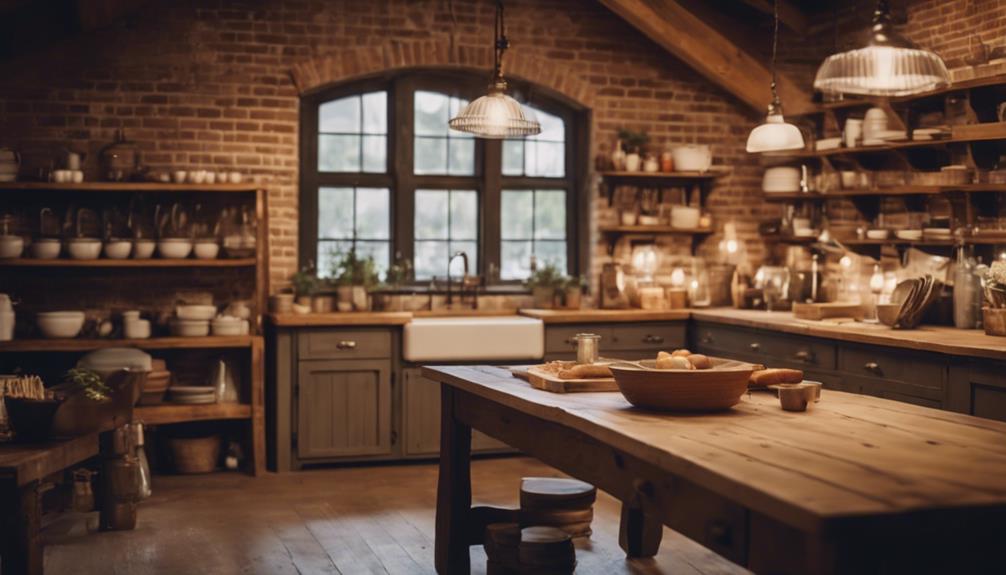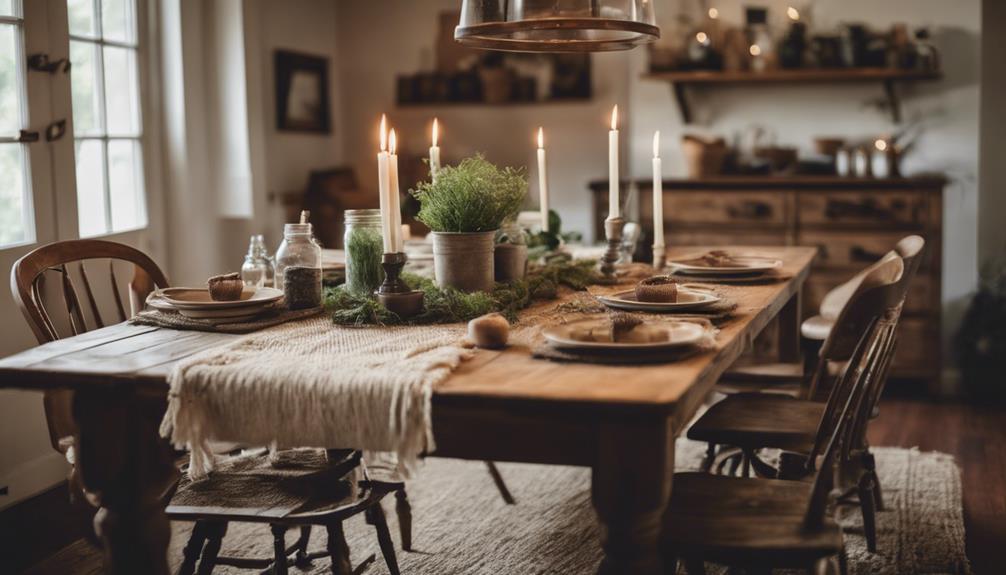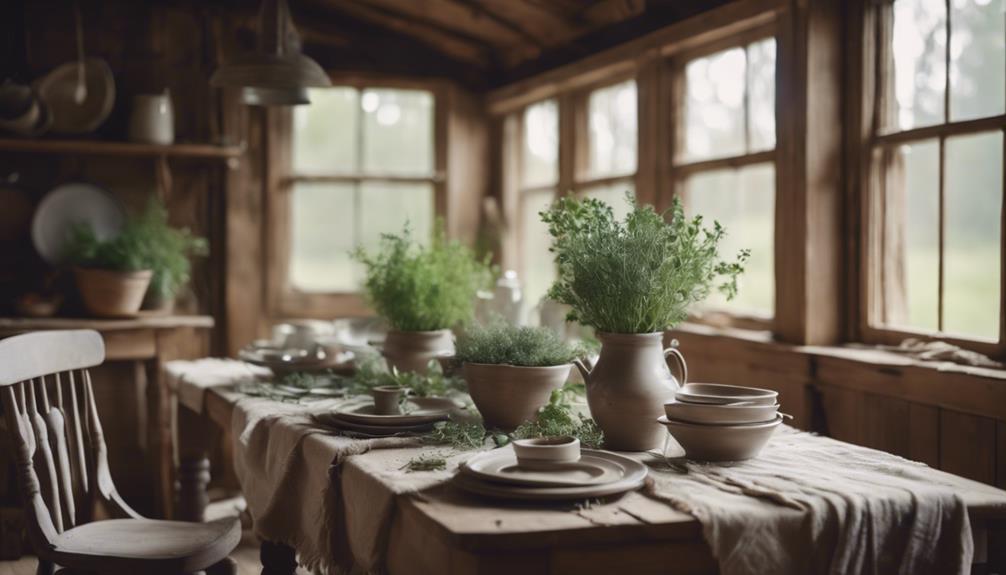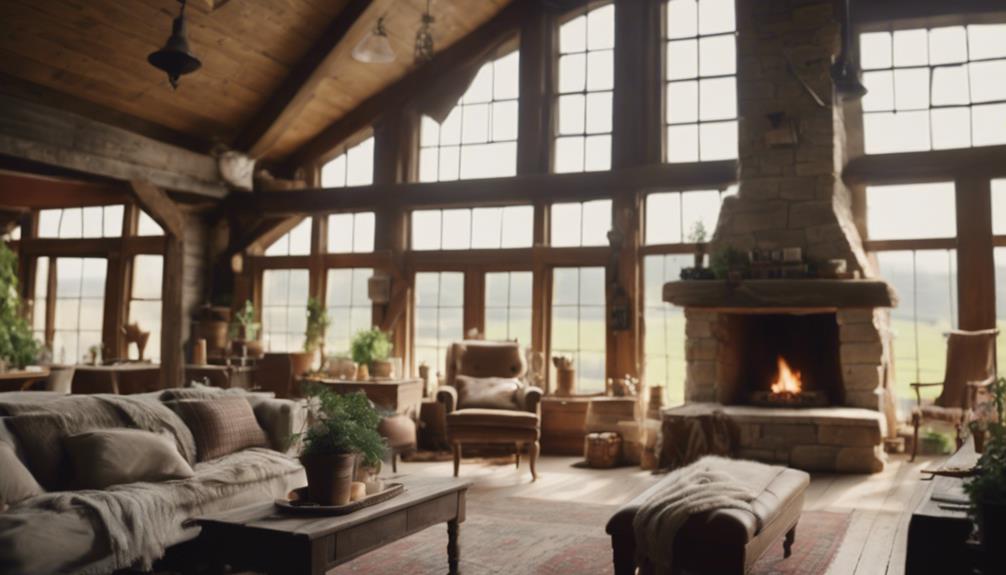Rustic farmhouse design brings together natural materials and cozy aesthetics, creating a timeless charm for your home. You’ll enjoy the warmth of reclaimed wood, soft neutrals, and oversized furniture that promotes comfort. Incorporate vintage textiles for added character and texture, while a mix of rustic lighting fixtures will enhance the overall ambiance. From a welcoming kitchen with a large island to cozy living spaces perfect for gatherings, every element complements each other beautifully. Personal touches such as family heirlooms and seasonal decor will make your space truly unique. Learn how to achieve this inviting atmosphere throughout your home in the following section.
Key Takeaways
- Emphasize natural materials like reclaimed wood and stone to create warmth and character in your rustic farmhouse design.
- Choose a neutral color palette with soft whites, grays, and earthy tones to establish a serene backdrop throughout your home.
- Incorporate oversized furniture pieces for comfort, while blending vintage and modern styles to enhance authenticity and charm.
- Use layered lighting, including rustic fixtures and dimmable options, to create a warm and inviting ambiance in every room.
Key Elements of Rustic Farmhouse Design
The key elements of rustic farmhouse design include natural materials, a neutral color palette, oversized furniture, vintage textiles, and architectural features that together create a warm and inviting atmosphere.
When you think of rustic spaces, envision reclaimed wood, stone, and metal that add character and warmth. These natural materials bring the outside in, making your home feel connected to nature.
A neutral color palette is essential in this design style. You'll often find soft whites, grays, and earthy tones that promote a serene, timeless aesthetic. This subtle backdrop allows other elements, like oversized furniture, to shine.
Large dining tables and plush sofas not only enhance comfort but also create a bold visual impact, making your living spaces feel welcoming.
To complete the cozy charm, vintage textiles play a vital role. Think quilts and rustic knits that add layers of texture.
Incorporating architectural features like shiplap walls and exposed beams evokes authenticity and timelessness, grounding your space in rustic elegance.
Furniture Selection and Arrangement

Choosing the right furniture and arranging it thoughtfully can transform your rustic farmhouse into a cozy and inviting haven.
Start with furniture selection that prioritizes comfort—consider oversized pieces like a large reclaimed wood dining table or a plush sectional. These not only enhance comfort but also create a striking visual impact in your space.
Mixing and matching furniture styles adds character, so don't hesitate to pair vintage chairs with a modern table. This eclectic approach showcases your personal style while maintaining authenticity.
Multi-functional pieces like storage ottomans or benches are great decorating ideas; they maximize space and provide extra seating as well as organization.
When it comes to arrangement, focus on promoting conversation. Position sofas and chairs in a U-shape around a coffee table to encourage social interaction in living areas.
Finally, opt for linen or cotton upholstery for your seating. This choice not only adds a relaxed feel but also complements your rustic aesthetic beautifully.
Lighting for Warm Ambiance

Creating a warm ambiance in your rustic farmhouse begins with selecting the right lighting fixtures that enhance both comfort and style. Oversized chandeliers can serve as striking focal points in high-ceilinged rooms, bringing a touch of elegance while maintaining that cozy atmosphere you desire.
Pair these with rustic lighting options made from wrought iron or distressed wood to beautifully complement the traditional architecture and earthy elements of your home.
To achieve layered lighting, consider incorporating wall sconces and vintage table lamps. These fixtures not only add to the aesthetic but also provide functional illumination throughout your space.
Placing your lighting strategically can highlight architectural features like exposed beams or stone fireplaces, creating a harmonious balance between natural and artificial light sources.
Don't forget about dimmable lighting options. They allow you to adjust the brightness, making it easy to shift between a relaxed, intimate setting and a lively gathering atmosphere.
With the right mix of ambient lighting and rustic fixtures, you'll cultivate a warm, inviting environment that reflects the timeless design of your rustic farmhouse.
Color Palette and Textures

When choosing a color palette for your rustic farmhouse, consider warm earthy tones that create a cozy atmosphere.
Pair these with textured fabric combinations, like leather and vintage textiles, to enrich the space.
Don't forget about nature-inspired accent walls, which can add depth and enhance the rustic charm of your home.
Warm Earthy Tones
Warm earthy tones, like soft whites, muted greens, and rich browns, instantly cultivate a serene and inviting atmosphere in rustic farmhouse design. These colors form the perfect backdrop for your space, allowing rustic elements to shine. You can use neutral walls to enhance the warmth of reclaimed wood furniture, creating depth and character throughout your home.
Here's a quick overview of how to incorporate warm earthy tones effectively:
| Color | Usage |
|---|---|
| Soft Whites | Walls & Trim |
| Muted Greens | Accents & Accessories |
| Rich Browns | Furniture & Flooring |
| Reclaimed Wood | Beams & Furniture |
When you decorate with these tones, consider adding contrasting colors, such as black and white, to highlight the charm of your vintage furnishings. Nature-inspired accent walls using shiplap or reclaimed wood can further enhance the rustic feel, seamlessly connecting your indoor space to the natural environment outside. Embracing warm earthy tones not only creates a cozy ambiance but also reflects the timeless beauty of farmhouse living.
Textured Fabric Combinations
Textured fabric combinations play a crucial role in achieving the inviting and cozy atmosphere characteristic of rustic farmhouse design. To create that warm ambiance, focus on incorporating textured fabrics like leather, vintage textiles, and chunky knits. These materials add warmth and depth to your living spaces, making them feel more homey.
Layering different textures is fundamental for establishing that cozy farmhouse vibe. You can mix and match plaid and check patterns to evoke a sense of comfort and style. The interplay of various textures not only enhances visual interest but also invites you to relax and unwind in your space.
Don't overlook the color palette, either. Warm and cool earth tones, along with soft whites and grays, will complement your textured fabrics beautifully. This combination creates a serene backdrop that highlights the richness of wooden tones found in rustic farmhouse design.
For a seasonal refresh, consider changing out quilts and upholstery. This allows your cozy farmhouse to evolve throughout the year while maintaining that inviting atmosphere you cherish. By thoughtfully combining textures, you can guarantee your home remains a warm retreat for family and friends.
Nature-Inspired Accent Walls
Nature-inspired accent walls bring the tranquility of the outdoors inside, using earthy greens, soft browns, and muted blues to establish a serene atmosphere that enhances rustic farmhouse decor.
To create your perfect accent wall, consider using natural materials like reclaimed wood, shiplap, or natural stone. These textures not only add depth but also tie in the rustic farmhouse aesthetic beautifully.
You might also want to incorporate botanical prints or wallpaper featuring nature motifs to further enhance the theme. This can draw inspiration from the surrounding landscape, fostering a calming environment that feels connected to nature.
Layering different materials can also create a dynamic accent wall; for instance, combining wood with stone or fabric can add visual interest and charm.
For a cohesive look, start with a soft white or light neutral base color for the wall. This allows your nature-inspired accents to stand out, creating an inviting space that feels warm and welcoming.
Kitchen Design Essentials

When designing a rustic farmhouse kitchen, key elements like white cabinetry, large islands, and farmhouse sinks come together to create a functional and inviting space. To achieve this charming aesthetic, focus on these essentials:
- White cabinetry: This provides a clean, fresh look while allowing other elements to shine.
- Large kitchen island: It offers ample counter space and serves as a gathering spot for family and friends.
Incorporating open shelving allows you to display your favorite dishware and decorative items, adding visual interest and warmth to your kitchen.
Pairing white cabinetry with gold accents can elevate the overall design, creating a sophisticated yet cozy atmosphere.
Additionally, consider vintage-inspired appliances from brands like Wolf and SubZero to blend modern technology with nostalgic aesthetics.
Cozy Living Room Ideas

To create a cozy living room, focus on comfortable seating arrangements that invite relaxation and conversation.
Pair these with warm lighting choices, like soft lamps and candles, to set a welcoming ambiance.
Together, these elements will transform your space into a true rustic retreat.
Comfortable Seating Arrangements
Creating comfortable seating arrangements in your living room often revolves around oversized sofas and sectionals that invite relaxation and conversation. To achieve a cozy and inviting farmhouse living room, consider these key elements:
- Use neutral-toned sofas or sectionals as your focal point.
- Incorporate natural materials like wood for rustic charm.
These comfortable seating arrangements not only enhance comfort but also reflect the modern farmhouse style. Position your seating around a central feature, such as a fireplace, to foster a warm gathering space. This symmetry creates an inviting atmosphere for family and friends.
Consider opting for slipcovered sofas, which offer easy maintenance while maintaining a relaxed aesthetic. They're perfect for family-friendly environments, ensuring your living room remains stylish yet practical.
Rustic elements like reclaimed wood coffee tables add character, seamlessly blending with your overall design.
Warm Lighting Choices
Comfortable seating arrangements naturally invite you to contemplate warm lighting choices that enhance the cozy atmosphere of your living room. To create that inviting space, consider incorporating oversized chandeliers that serve as stunning focal points, especially in rooms with high ceilings. They not only illuminate the room but also contribute to the warm ambiance you desire.
Layer your lighting with various fixtures, like table lamps and wall sconces, which provide multiple sources of light. This flexibility allows you to adjust the brightness according to the time of day and your mood. Rustic lighting fixtures made from wrought iron or reclaimed wood beautifully complement farmhouse decor, adding warmth and character to your space.
Don't overlook the benefits of dimmable lighting options. These give you greater control over brightness, fostering an inviting and relaxed environment. Finally, choose soft, warm-toned bulbs to mimic the gentle glow of natural light, enhancing the rustic elements of your farmhouse aesthetic. By carefully selecting your lighting choices, you can transform your living room into a cozy retreat where you can unwind and feel at home.
Inviting Dining Room Features

An inviting dining room effortlessly blends rustic charm with modern touches, making it the perfect setting for memorable gatherings. To create this warm atmosphere, consider these key features:
- A dark walnut dining table provides a classic contrast to lighter elements.
- Linen dining chairs with nailhead trim enhance both comfort and style.
When you think about wall colors, opt for soft hues that complement neutral furniture, creating a serene backdrop. This choice fosters a welcoming environment where friends and family can relax.
The beauty of farmhouse design lies in its ability to marry traditional and modern elements, making each meal feel special.
Incorporate decorative details like vintage dish displays and textured table settings to elevate your dining experience. These accents not only enrich the aesthetics but also invite conversation and connection.
Bedroom Comforts and Aesthetics

When designing your bedroom, soft neutral palettes can create a serene atmosphere that promotes relaxation.
Pairing an elegant tufted bed with cozy textiles adds both comfort and style, making your space inviting.
Don't forget to incorporate thoughtful accent choices that enhance the overall aesthetic and warmth of your rustic farmhouse retreat.
Soft Neutral Palettes
Soft neutral palettes create a calming sanctuary in bedrooms, inviting relaxation and enhancing overall aesthetics. By incorporating soft whites, grays, and earthy tones, you can establish a serene atmosphere that promotes comfort and restful sleep.
Consider these elements to enrich your bedroom's design:
- Soft whites for a fresh, airy feel
- Earthy tones to ground the space and provide warmth
Imagine a tufted ivory bed paired with traditional nightstands; this combination exudes elegance while maintaining an inviting vibe. You can also create an accent wall painted in soft colors, which not only adds depth but also breaks up monotony. This approach keeps the room visually engaging while preserving that calming vibe essential for relaxation.
To further enhance your sanctuary, introduce vibrant pops of color, like blue throw pillows or a patterned blanket. These small touches provide invigorating contrasts, making your space feel lively yet harmonious.
Ultimately, soft neutral palettes help you craft a bedroom that's both stylish and a haven for rest.
Elegant Bed Designs
Elevate your bedroom with elegant bed designs that blend comfort and aesthetics, creating a truly inviting retreat. Consider a tufted ivory bed that not only serves as a focal point but also adds a touch of sophistication to your rustic farmhouse style. Pair it with traditional nightstands to enhance the cozy atmosphere.
To promote relaxation, stick to soft neutral palettes like whites and grays in your decor. These colors not only foster a sense of calm but also elevate the overall aesthetic appeal of your space. Adding an accent wall in a soft hue can introduce depth and interest, making your bedroom feel more inviting.
Don't forget about layering textiles to create a chic vibe. Incorporate vibrant throw pillows against your neutral bedding to add that perfect pop of color while keeping the comfort level high.
Finally, consider hanging art or mirrors above your nightstands. This simple addition not only creates dimension but also adds a polished finish, enhancing the elegance of your bedroom decor.
With these elegant bed designs, you'll transform your bedroom into a stylish and serene sanctuary.
Cozy Textile Choices
Incorporating cozy textile choices can greatly enhance the comfort and aesthetics of your rustic farmhouse bedroom. By selecting the right fabrics and patterns, you can create a welcoming atmosphere that invites relaxation. Consider these elements to elevate your space:
- Soft neutral palettes to promote tranquility
- Vintage quilts that add character and warmth
Opt for linen and cotton fabrics, which are ideal for bedding and drapery, as they contribute to a relaxed vibe. Vintage quilts not only introduce color and texture; they also tell a story, connecting your space to heritage and nostalgia. Layering various textile patterns, like plaid and check, can enhance the rustic feel while providing visual interest.
To keep your bedroom fresh, think about seasonal updates with textiles. Changing out quilts or adding new throw blankets can revitalize the look without sacrificing coziness. By embracing these cozy textile choices, you'll create a bedroom that perfectly balances comfort and rustic charm, making it a true sanctuary in your farmhouse home.
Outdoor Spaces and Decor

Outdoor spaces can be transformed into charming retreats with the addition of cozy rockers and inviting furniture that beckon you to relax and enjoy the fresh air.
By incorporating elements like garden beds and planters, you foster a connection to nature, adding vibrant greenery that enhances the rustic farmhouse aesthetic.
To create an inviting atmosphere, consider using outdoor lighting such as string lights or lanterns. These not only illuminate your space but also add a warm glow that's perfect for evening gatherings.
A fire pit can serve as a central gathering spot, providing warmth and ambiance, making your outdoor spaces ideal for entertaining friends and family.
Using natural materials like reclaimed wood and stone in your outdoor decor reinforces the rustic farmhouse style, blending seamlessly with the environment.
Opt for furniture made from these materials to enhance the overall vibe.
Personal Touches in Decor

Adding personal touches to your rustic farmhouse decor transforms your space into a reflection of your unique story and style. By incorporating elements that resonate with you, your home becomes a warm haven filled with memories and character.
Here are a few ideas to inspire your personal touches:
- Create a Gallery Wall: Display family photos and custom artwork to showcase your journey and cherished moments.
- Incorporate Vintage Signs: Use vintage signs to add personality and charm, reinforcing the farmhouse feel while telling a story.
Seasonal decor updates, like themed wreaths and accents, allow you to express yourself throughout the year, keeping your space fresh and inviting.
By mixing these elements, you'll not only enhance the aesthetic but also create a home that feels truly yours. Remember, every piece you choose can add a layer of warmth, ensuring your rustic farmhouse is a genuine reflection of you and your loved ones.
Embrace the beauty of personal touches, and watch as your space flourishes with life and memories.
Frequently Asked Questions
What Decor Style Is Replacing Farmhouse?
Modern Minimalism and Scandinavian design are increasingly replacing farmhouse decor. You'll find clean lines, light palettes, and natural materials prioritizing functionality, while industrial, bohemian, and sustainable styles also offer fresh, vibrant alternatives for your space.
What Is the Difference Between Rustic and Farmhouse Design?
Rustic design focuses on raw materials and a rugged feel, while farmhouse blends these with modern comforts and a lighter palette. You'll find farmhouse decor more polished, integrating vintage elements with contemporary touches for a cozy atmosphere.
Is Farmhouse Style Timeless?
Isn't it comforting to know that farmhouse style is timeless? You'll find its blend of warmth, practicality, and natural materials resonates through generations, creating inviting spaces that foster family connections and enduring memories.
How Do You Style a Rustic Farmhouse?
To style a rustic farmhouse, incorporate natural materials, use a warm neutral palette, and layer textures. Select oversized furniture and add vintage accents to create a cozy, inviting atmosphere that reflects your personal history.
How Can I Incorporate Timeless Rustic Farmhouse Design Into My Home?
Incorporating timeless rustic farmhouse design into your home is a great way to add warmth and character. To achieve the best farmhouse styles 2024, opt for natural materials like wood and stone, vintage decor pieces, and a neutral color palette. Embrace imperfections and simplicity to create a cozy, inviting space. Consider incorporating elements such as exposed wooden beams, reclaimed furniture, and sliding barn doors to enhance the farmhouse aesthetic. To bring in a touch of nostalgia, mix in some vintage finds like old milk jugs, Mason jars, and galvanized metal accents. These farmhouse interior design ideas will help create a timeless and charming atmosphere in your home.
Conclusion
Embracing rustic farmhouse style might seem like a leap into the past, but it's actually a step toward timeless comfort.
You'll find that blending aged charm with modern convenience creates a paradox: the old feels new again.
As you curate personal touches and warm textures, you're not just decorating but crafting a haven that's both nostalgic and fresh.
So, go ahead, invite the rustic into your home—who knew cozy could be so chic?









